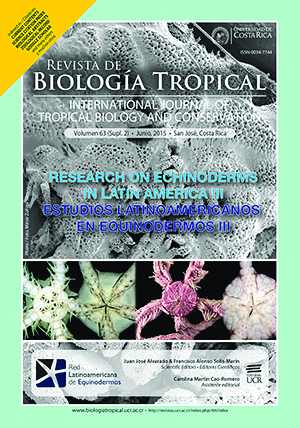Abstract
Astropyga pulvinata is a sea urchin of the family Diadematidae that have five pairs of series of blue iridescent spots on interambulacral zones, from in vivo observation of 20 individuals under stereo-microscope and Scanning Electron Microscope analysis identification, the pedicellariae, spicules, and calcareous rosettes. The pedicellariae of A. pulvinata have three valves and are of three types: claviform, present on ambulacres; tridentates present on peristome and triphyllous present all over the test except in interambulacral areas. So ophicephalous pedicellariae are not bounded with a calcareous stalk. Ten types of spicules were observed from different soft tissues: one type from the intestine; three from the anal membrane; and six from the peristome, two of them constitute new diagnostic characters. One of them having a bat-shaped form and the other one with a waning crescent shape. In vivo observations showed that the blue iridescent spots were present on interambulacral areas as group of 35 cells bounded, and that other smaller spots were present on the ambitus, composed by eight cells.
References
Alvarado, J. J. (2008). Seasonal ocurrence and aggregation behavior of the sea urchin Astropyga pulvinata (Echinodermata: Echinoidea) in Bahia Culebra, Costa Rica. Pacific Science, 62, 579-592.
Campbell, A. C. (1972). The form and function of the skeleton in pedicellariae from Echinus esculentus L. Tissue & Cell, 4, 641-661.
Caso, M. E. (1978). Los equinoideos del Pacífico de México Parte primera- Órdenes Cidaroida y Aulodonta, Parte segunda- Ordenes Stiridonta y Camarodonta. Anales del Instituto de Ciencias del Mar y Limnología, Universidad Nacional Autónoma de México, 1, 1-244.
Caso, M. E. (1990). I. Las especies del género Hesperocidaris Mortensen, Astropyga Gray, Arbacia Gray y Lytechinus Agassiz, colectadas en las campañas oceanográficas Cortés 1, 2, 3 a bordo del B/O “El Puma”. Anales del Instituto de Ciencias del Mar y Limnología, 17, 83-94.
Coppard, S. E., & Campbell, A. C. (2006). Systematic significance of tridentate pedicellariae in the echinoid genera Diadema and Echinothrix. Invertebrate Biology, 125, 363-378.
Coppard, S. E., Kroh, A., & Smith, A. B. (2010). The evolution of pedicellariae in echinoids: an arms race against pests and parasites. Acta Zoologica, 93, 125-148.
D’yakonov, M. A. (1969). Fauna of Russia and adjacent countries. Echinodermata. Volume I. Echinodea. Jerusalem, Israel: Program for Scientific Translation.
Killian, C. E., & Wilt, F. H. (2008). Molecular aspects of biomineralization of the echinoderm endoskeleton. Chemical Reviews, 108, 4463-4474.
Kroh, A., & Smith, A. B. (2010). The phylogeny and classification of post-Palaeozoic echinoids. Journal of Systematic Palaeontology, 8, 147-212.
Lawrence, J. (1987). A functional biology of echinoids. The Johns Hopkins University Press. Florida.
Mortensen, T. (1940). A monograph of the Echinoidea III1 Aulodonta with additions to vol. II (Lepidoncentroida and Stirodonta). Copenhagen: Reital Publisher.
Mortensen, T. (1977). Handbook of Echinoderms of British Isles. The Netherlands: Claredon Press Oxford.
Ruppert, E. E. & Barnes, R. D. (1996). Zoología de los Invertebrados. México: Mc Graw Hill Interamericana.
Solís-Marín, F.A., Arriaga-Ochoa, J., Laguarda-Figueras, A., Frontana-Uribe, S., & Durán-González, A. (2009). Holoturoideos (Echinodermata: Holothuroidea) del Golfo de California. México: CONABIO ICML-UNAM.
Solís-Marín, F.A., Alvarado, J. J., Pérez-Ruzafa, A., Hernández, J. C., Morata, A., Marcos, C., … Williams, S. M. (2013). Appendix. In. J. J. Alvarado & F. A. Solís-Marín (Eds.), Echinoderm research and Diversity in Latin America (pp. 543-654). Berlin: Springer
##plugins.facebook.comentarios##

This work is licensed under a Creative Commons Attribution 4.0 International License.
Copyright (c) 2015 Revista de Biología Tropical






